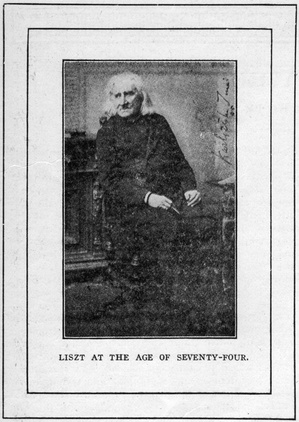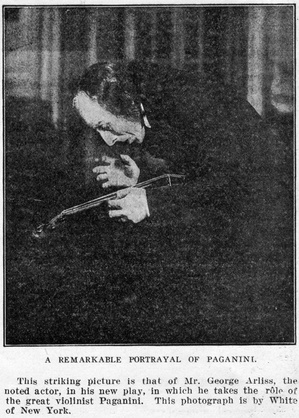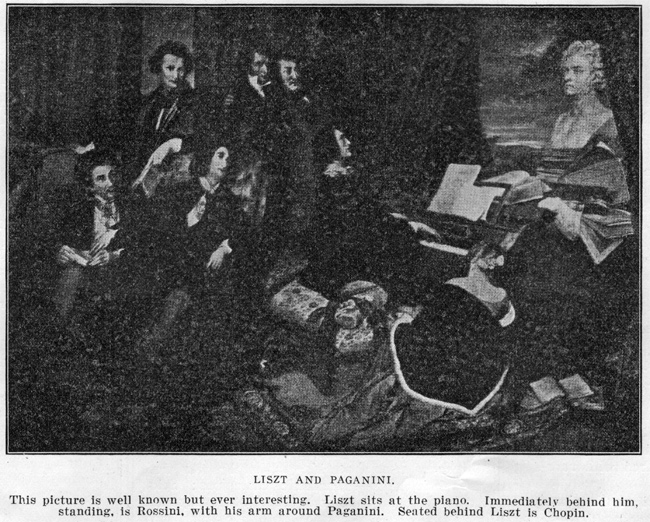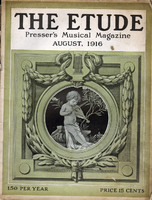By HENRY T. FINCK
Franz Liszt reached the ripe age of seventy-five. He lived a life crowded, as few lives have been, with hard work, romantic episodes, splendid triumphs, deep disappointments. It is not strange that he repeatedly alluded in the letters of his last years to the tædium vitæ. He had become tired of life, having exhausted its joys as well as its sorrows. What is strange is that he had an attack of this tædium vitæ when he was a mere youth—an attack so severe that he decided to say farewell to the musical world and enter the Church. From his early years his mind had been inclined toward religion; but there were other reasons which affected him at this time, among them a disappointment in love, a long illness, an inborn aversion to the career of a public performer, and the necessity of giving lessons to support himself and his mother in Paris, because his recitals were not well-attended. At one time he was so short of funds that he sold his piano to buy bread.
When we consider the many ways in which Liszt, during his long career, helped along music and musicians, we realize that it would have been nothing short of a calamity if, at the age of twenty-one, he had followed this inclination to become a priest.
What averted the calamity was Paganini’s violin playing.
Niccolo Paganini arrived in Paris in March, 1831, on a tour which set all Europe aflame with wonder at the amazing brilliancy of his playing. He performed tricks with harmonics, double stopping and treble stopping, arpeggios, springing bow, together with “guitar effects,” pizzicato and arco simultaneously, and other things that astonished not only “the natives” but rival violinists, who could not understand how he did them. Liszt heard him, and like a flash the thought came to him: “What wonderful things might be done with the piano if its technical possibilities were developed as those of the violin have been by Paganini.”
 He made up his mind to do this himself. Thenceforth he shunned appearing in public or in society, devoting most of his time to experimenting on the piano; and when, after three years of assiduous practice, he gave another recital, the Parisians applauded him as frantically as they had applauded Paganini. He had become the Paganini of the piano, performing feats of virtuosity which no other player could equal.
He made up his mind to do this himself. Thenceforth he shunned appearing in public or in society, devoting most of his time to experimenting on the piano; and when, after three years of assiduous practice, he gave another recital, the Parisians applauded him as frantically as they had applauded Paganini. He had become the Paganini of the piano, performing feats of virtuosity which no other player could equal.
A Frank Confession
While the public applauded, the critics jumped on Liszt with both feet, on the ground that he took liberties with classical works, playing them arbitrarily and introducing inappropriate ornaments. That they were justified in censuring him he admitted four years later, in a letter to George Sand, in which he confessed his guilt in these contrite words: “In concert halls as well as in private drawing rooms I often played works of Beethoven, Weber, and Hummel, and I am ashamed to say that for the sake of winning the applause of a public which was slow in appreciating the sublime and beautiful, I did not scruple to change the pace and the ideas of the compositions; nay, I went so far in my frivolity as to interpolate runs and cadenzas which, to be sure, brought me the applause of the musically uneducated, but led me into paths which I fortunately soon abandoned. I cannot tell you how deeply I regret having thus made concessions to bad taste, which violated the spirit as well as the letter of the music. Since that time absolute reverence for the masterworks of our great men of genius has completely replaced that craving for originality and personal success which I had in the days too near my childhood.”
Note the date of this confession—1837. Liszt was then only twenty-six years old, and for the remaining forty-nine years of his life he preserved that “absolute reverence” for masterpieces which he had already acquired when he wrote that letter to the famous French novelist. Yet to this day writers who ought to be ashamed not to know better speak of Liszt as one who, like Paganini, continued all his life to make the personal display of technical skill the one object of his activity. A flagrant offender is Mr. Fuller-Maitland, who was for some years the musical critic of the London Times and was chosen as editor of the second edition of Grove’s monumental Dictionary of Music and Musicians. In the preface to the Correspondence of Joachim, he classes Liszt with those musicians who worked “for their own glorification rather than in the cause of legitimate music.”
This verdict applies only to the first decade of Liszt’s activity as a musician. Concerning the remaining years—nearly half a century—it is an unpardonable misstatement. During that half-century Liszt was the exact opposite of Paganini in everything except his dazzling technical skill as a player.
In 1841, shortly after Paganini’s death, Liszt wrote a remarkable essay in which he declared that the death of that Italian violinist signified the end of virtuosity: that is, of the display of skill for its own sake and the glorification of the player. “May the artist of the future,” he added, “cheerfully drop the vain, egotistic part which, we hope, found in Paganini its last brilliant representative; may he place his goal within and not without himself; and may virtuosity be a means to him, never an end in itself.”
Fetis, the famous Belgian scholar and historian, who wrote a book on Paganini which is filled with enthusiasm for his virtuosity, was obliged to admit that he was not a great interpreter, but was really quite second-rate when it came to playing anything except his own show-pieces. “In his concerts in Paris he thought it necessary to flatter the national feeling by playing a concerto by Kreutzer and one by Rode—but he scarcely rose above mediocrity in their performance.” There was a certain “fulness and grandeur in his phrasing, but there was no tenderness in his accents;” no true expression. He never reached the pinnacle of those artists who are interpreters as well as virtuosi—artists who make the public forget the player because he makes the music itself so interesting; just as the greatest actors make the spectators forget them in the characters they personify.
Liszt Admired by the Greatest Composers
That Liszt, unlike Paganini, was a genuine interpreter was attested to by the great composers of his time who heard him play their works. Even Mendelssohn, who could not be expected to have much sympathy with him, declared, after hearing him perform his (Mendelssohn’s) G minor concerto, that “it could not be played more beautifully—it was wonderful.”
Schumann wrote to Clara Wieck in 1840: “I wish you could have heard Liszt this morning. He is most extraordinary. He played some of my own compositions—the Novelettes, the Fantasia, the Sonata—in a way that moved me deeply. Many of the details were quite different from the way I conceived them, but always inspired by genius.” In the third volume of Schumann’s collected critical writings nine pages are devoted to a eulogy of Liszt, in which he dwells among other things on his incomparable way of playing Chopin’s pieces. All this is the more remarkable, because Schumann did not naturally sympathize with Liszt’s aims any more than he did with Wagner’s, and there was at that time a remnant of Paganinism in Liszt which did not escape his censure.
Chopin, in one of his letters, says, “I write to you without knowing what my pen is scribbling, for Liszt is at this moment playing my etudes and he transports me out of my proper senses. I should like to steal from him his way of playing my pieces.”
When Grieg took the manuscript of one of his violin sonatas to Liszt in Rome the great pianist played it at sight—both piano and violin parts. “He was literally over the whole piano at once, without missing a note,” Grieg relates in a letter, “and how he did play! With grandeur, beauty, genius, unique comprehension. I think I laughed—laughed like an idiot.”
Mendelssohn, Schumann, Chopin, Grieg, represent sufficient diversity of style to indicate Liszt’s versatility as an interpreter. He had, as Germany’s chief historian of music, Professor Hugo Riemann, has pointed out, “a previously unknown capacity for entering into the peculiarities of the most widely separated epochs, styles, and individualities.” Without doubt Bach, Beethoven, Schubert, and all the other masters who wrote piano pieces would have been as delighted with Liszt’s interpretation of them as were those just named. Berlioz confessed that Beethoven’s Sonata, Opus 106, was a riddle to him till Liszt solved it. “He is the pianist of the future.”
Concerning the same sonata, and Beethoven’s Opus 111, Wagner declared that Liszt first enabled him to understand them. Concerning his playing of Bach’s C sharp minor prelude and fugue Wagner wrote, “I knew, of course, very well what was to be expected of Liszt at the piano, but what I heard when he played this piece I had not anticipated, although I had studied Bach thoroughly. This experience showed me how slight is the value of study as compared with revelation.”
 Obviously, if Liszt was the Paganini of the piano, he was at the same time infinitely more than that—so much so that in the minds of those who knew the real Liszt, Lisztism soon came to mean the exact opposite of Paganinism—the art of an interpreter versus that of a mere virtuoso.
Obviously, if Liszt was the Paganini of the piano, he was at the same time infinitely more than that—so much so that in the minds of those who knew the real Liszt, Lisztism soon came to mean the exact opposite of Paganinism—the art of an interpreter versus that of a mere virtuoso.
Wagner’s judgment is particularly interesting. He first heard Liszt play in Paris in 1841—the very year of Liszt’s essay on Paganini; and to his horror, he heard him play a fantasia on Meyerbeer’s Robert the Devil, as an encore at a concert devoted to Beethoven! But he realized, too, that Liszt was not to blame. The public simply yelled and clamored for that show piece till he sat down, visibly annoyed, and muttering, “I am the servant of the public, as a matter of course,” played the piece called for.
“Thus,” Wagner adds humorously, “all guilt has to be atoned for in this world. Some day Liszt will be obliged in heaven to play before the assembled angels his fantasia on the devil! But that will probably be the last time!”
Poor Liszt! The world made it very hard for him to be good, artistically and otherwise.
And yet—there is a point of view from which even the playing of that fantasia on a Meyerbeer opera may be justified. Liszt had previously revealed to the
Parisians what astonishing sounds and combinations can be evoked from the piano. Beethoven’s compositions gave him no opportunity to exploit these new pianistic discoveries. Therefore we must not be too hard on the Parisian audience for clamoring for a specimen of the latest pianistic improvements.
In Italy, even Liszt could have given no recitals at all had he not played his brilliant operatic fantasias. He tried the Chopin ètudes, but was informed that “studies” belonged in the studio, not in the concert hall. Let me cite one more historic fact by way of showing how difficult it was for Liszt, at that time, to be an angel or a model of good taste. In 1837 a charity concert was given in Paris at which six of the greatest pianists of the day appeared: Chopin, Czerny, Pixis, Herz, Thalberg and Liszt. Each had his own piano—and what do you suppose each one played? A set of his own variations on the march from Bellini’s opera, I Puritani! Liszt, who came last, looked on the thing as a joke, amusing himself and the audience by giving a sort of “review” of the style and mannerisms of his colleagues.
The Piano as Miniature Orchestra
One of the results of Liszt’s temporary craze over Paganini was that he made a transcription for piano of that violinist’s Twenty-four Caprices. Not long afterwards he made an arrangement for the piano of Berlioz’s Symphonie Fantastique—a significant act, for it calls attention to the trend of Liszt’s treatment of the piano. He could not write more idiomatically—that is pianistically—for the piano than Chopin was writing at that very moment; but he could transfer orchestral scores to the piano and make them sound as idiomatic as Chopin’s pieces for piano or Paganini’s for violin. Therein lies one of the great achievements of Liszt, with which he influenced all the pianists and composers that came after him. His own words on this point are interesting: “We make broken chords like the harp, long-drawn tones like the wind instruments, staccati and a thousand kinds of passages which formerly it appeared possible to bring forth only from this or that particular instrument.” As one of his pupils exclaimed, “He orchestrates with his fingers.”
Although no one could play more tenderly than he, his was the orchestral way—grand, impetuous, sublime. Among the works he translated for pianists are Beethoven’s symphonies. He played them in public, too! To us this seems absurd—Paderewski would never dream of doing such a thing. But it must be remembered that in those days good orchestras were very scarce, and good interpreters of Beethoven’s symphonies scarcer. Wagner attests that there were places in these orchestral scores that were not made clear till Liszt translated them into the language of the piano.
What Liszt did for the piano was infinitely more than what Paganini had done for the violin. The greatest pianists—such men as Paderewski, Joseffy, Hofmann, D’Albert, Gabrilowitsch, Busoni, Pachmann, Friedheim, Schelling—are the most ardent admirers of his achievements for the piano, simply because they know most about them—just as those conductors who knew or know most about his orchestral works were and are their most enthusiastic champions: Seidl, Richter, Weingartner, Nikisch, Muck, Stransky, and all the others who, during the last half century, have risen above mediocrity.
The greatest violinist of our time, Fritz Kreisler, very seldom plays Paganini, but I know of no great pianist who does not often play Liszt. One could be an up-to-date violinist without knowing anything about Paganini’s achievements, but no one could be a first-class pianist without knowing of Liszt’s innovations, which influenced even Chopin, and which have helped all pianists and composers for the piano since that time.
Saint-Saëns declared, without exaggeration, that Liszt’s influence on the piano was so great that he knew of nothing comparable to it except the revolution in the mechanism of the French language brought about by Victor Hugo. In his Portraits et Souvenirs he gives illuminating glimpses of what this pianistic revolution consisted in.
German Songs and Hungarian Rhapsodies
Liszt also translated into the language of the piano many of the best songs of Beethoven, Schubert, Schumann, Franz, Chopin and other masters, making them as idiomatic as if they had been composed for his instrument. The recognition of Schubert as the greatest of all song writers dates from the time when Liszt began to play his Lieder in public. By the singers they had been neglected till the delight given by Liszt to his audiences showed them their folly.
These were some of the ways in which Liszt “worked for his own glorification rather than in the cause of legitimate music”! But there is much more to come, all of which will read like a sarcastic commentary on Fuller-Maitland’s sagacious criticism.
Are folk tunes “legitimate music?” Ask the great masters. Nearly all of them, from Bach and Haydn to Grieg and Tchaikovsky, have been inspired by these tunes and have woven them into their compositions. None of these masters, however, used them on such a large scale, and with such varied artistry as Liszt did when he gathered the delightful Magyar tunes of Hungary, with their spicy Gipsy ornaments, and shaped them into his wonderful rhapsodies. It was a deed comparable to that of Homer in giving coherence to the scattered tales of the Greeks in his Iliad and Odyssey.
There are many marvels of appropriate harmonization and coloring in these rhapsodies; when they are played by Paderewski one can hear the very sounds of the gipsy instruments More than once I have read the statement that Liszt, Paganini-like, wrote these dazzling rhapsodies to show off his brilliant pianism. As a matter of fact he wrote all of them after he had ceased to play in public. He wrote them for the glorification of his native country. In them, and in those of his compositions (including the symphonic poem Hungaria), which are tinged with national colors, he gave Hungarian music artistic rank, as Chopin did to Polish, Grieg to Norwegian, Dvorak to Bohemian music. Liszt’s rhapsodies are as important art works as Beethoven’s sonatas. Personally I enjoy them more. For interesting details regarding them see the introduction by August Spanuth to an edition of Liszt’s best Rhapsodies.
How far away we are traveling from Paganini! He cared nothing for the art of his country or of any composer, his only object being to arouse astonishment by his feats and accumulate a fortune. While Liszt was the noblest, most generous of mortals, Paganini was ignoble and a miser. The one generous act credited to him has been proven a myth. He earned millions of francs. Liszt might have done the same during the last thirty-nine years of his life, when everybody was imploring him to return to the concert halls; but not one cent did he thus earn. Occasionally, during those years, he did play in public, but always for charity.
Nor did he accept payment from any of the hundreds of pupils from all parts of the world who came to him during those years, at Weimar, Budapest or Rome. And while he refused to play in public for money, he freely played for his pupils, because he knew, as well as Wagner, that “revelation teaches more than study.”
(A second section of this article will appear in the September issue of The Etude.)




